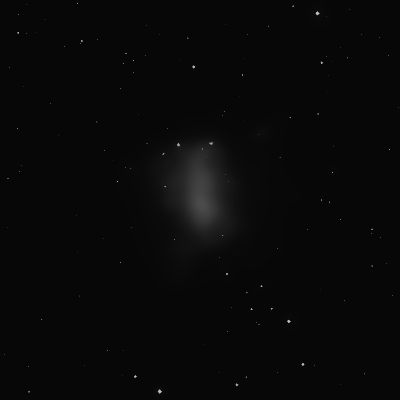Barnard's Galaxy
Barnard's Galaxy

200/250mm - 8" (8/28/81): very faint, elongated N-S, similar to a faint Milky Way patch.
400/500mm - 17.5" (7/14/99): the exact position of the HII ring Hubble III on the NW side of the galaxy was examined carefully at 280x without a filter and on several occasions an extremely faint, round, 15" glow popped into view with averted vision ~1.5' W of a mag 13.5-14 star. A mag 15.5 star is visible a similar distance SSE of the reference star. This HII knot was clearly nonstellar, although it didn't have the annular ring appearance seen on images. Viewed on an evening of exceptional transparency at the Sierra Buttes.
17.5" (5/10/91): at 82x, this Local Group Member appeared fairly faint, very large, low but uneven surface brightness, elongated 5:2 N-S, 14'x6'. Diffuse appearance and the boundary is difficult to define, requires low power. Several faint stars are superimposed with a couple of brighter stars on the north side. Using an OIII filter two small, faint HII knots (Hubble X = IC 1308 and Hubble V) stand out well on the north and NW edges. Both of these knots are 2' NW of mag 12 stars. Planetary nebula NGC 6818 lies 40' NNW.
17.5" (7/16/88): easily visible as a large, elongated, low surface brightness glow.
900/1200mm - 48" (5/16/12): the four HII regions on the north side of the galaxy were carefully observed. IC 1308 = Hubble X appeared bright, fairly small, irregularly round. At ~30" diameter this HII knot is slightly larger than Hubble V and more uniform in surface brightness. Hubble V is bright, fairly small, irregularly round. This irregular HII region spans 20"-25" and has a higher surface brightness than IC 1308 3' E. A bright knot is on the SE end. Hubble III was immediately visible as a faint to fairly faint glow, fairly large (largest of the four regions), round, ~0.9' diameter. Occasionally, when the seeing steadied the ring structure popped and a brighter rim and darker center was visible. Smaller and slightly fainter Hubble I is virtually in contact at the NW edge and sometimes the two glows merged into a single large, irregular glow. Hubble I is the faintest and westernmost of the main HII regions and appeared as a faint, moderately large, round glow of ~36" diameter, barely off the NW side of larger Hubble III.
Notes by Steve Gottlieb